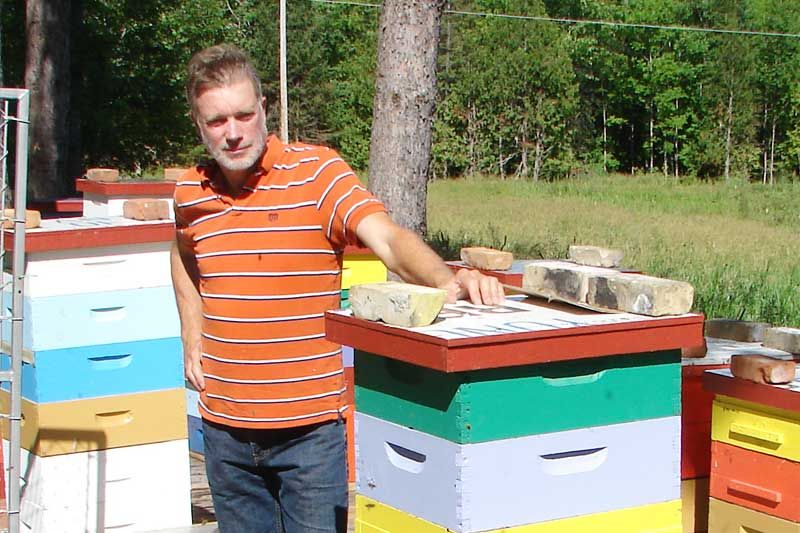Malcolm Callister | Aug 17, 2016
To visit the bee colonies of Markus Sanders of Crooked Hill Farm, north of Sharbot Lake, is to experience a kaleidoscope of color. Each year Saunders encourages his daughters to select the colours to paint the individual hive boxes, or supers.
Knowing that bees visually identify their hive, I asked him if this was an aid to assist returning bees to help them find their own hive. No, he assured me, it’s a simple trick to start getting his daughters involved in the family beekeeping business.
Saunders has 120 colonies of European honeybees in his apiaries on his 230-acre farm, and sells his honey locally at the Sharbot Lake Farmers Market.
Honeybees provide a pollination service to our crops. Crop yields can increase dramatically when there are plenty of honeybees in the area.
There has been a lot of discussion and government research carried out over the past few years into the dramatic losses being sustained by the bee industry.
Strong colonies, says Saunders, and his forest location have helped him avoid major hive die-offs or the feared Colony Collapse Disorder (CCD). Bee colony winter die-off rates have risen drastically, along with mite infestations, over the past two decades. These two problems are now major control issues for beekeepers. CCD was unknown 15 years ago in North America but it is now a real and well-debated issue for beekeepers. The bees leave with no regard for their own survival; they leave full frames of honey, and the young and the old. This is not the action of the caring bee communities that had existed prior to CCD hitting the hives.
To help maintain a healthy colony, Saunders will replace the queen bee in each colony every two years. He has also taken smaller, weaker colonies and blended them together with only one strong queen. In this case, he used a copy of the Frontenac News as the dividing screen between the two initial colonies, together with a queen metal separator. Bees of individual colonies distinguish each other by a unique scent. A bee from one hive will not be allowed into another hive. With the paper separating the two colonies, by the time the paper is chewed up, the scent given off by both initial colonies is the same and the total acceptance of each other has been established.
Beekeepers, crop and fruit farmers are working with government scientists to help build harvest yields and strong healthy bee colonies. At this time we do not appear to have the complete answer to hive die-off and CCD.
More Stories
- Sticker Shock - EV Charging Station To Cost North Frontenac Township
- 30th Anniversary Verona Car Show
- The Forgotten Comfort Veg - Eggplant
- MERA Stage Comes Alive This Fall
- North Frontenac Council Report - August 27
- Addington Highlands Council Report - September 2
- Here's Grief - Have You Met
- Burn Ban Off in North Frontenac, Addington Highlands - Reduced to Level One in South and Central Frontenac
- The Resurgent Sharbot Lake County Inn and Crossing Pub
- Towards Then End of Trail

